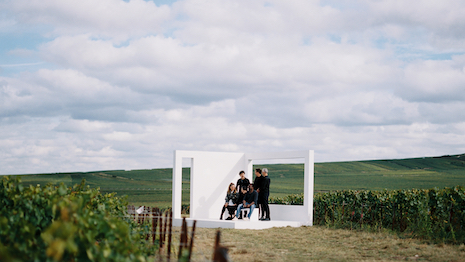 In the Champagne region, the artists will make creations that express humankind's relationship with nature. Image credit: Ruinart
In the Champagne region, the artists will make creations that express humankind's relationship with nature. Image credit: Ruinart
LVMH-owned Champagne house Ruinart is once again turning to the creative world to uplift an essential ingredient for its products: sustainability.
In a brand first, the annual Carte Blanche commission is going to six artists, each tasked with exploring humankind’s relationship with the earth. Their work will be unveiled this year at fairs around the world through the “Conversations with Nature” series, inclusive of American “artivist” Andrea Bowers, British installation artist Marcus Coates, Japanese musician Tomoko Sauvage, Cameroonian visual artist Pascale Marthine Tayou, Brazilian sculptor Henrique Oliveria and Dutch ecological artist Thijs Biersteker.
“I think art reflects the time it is in; it creates icons of its time, just like luxury brands,” said Mr. Biersteker, Amsterdam.
“In a sense, I feel that LVMH’s support of my topic, that of biodiversity and climate science, is a great match as we overlap in goals,” he said. “LVMH and I met at UNESCO while doing work there, and I think they support the course I’m on.
“I create work at the edge of art and science, and this recognition is both humbling and motivating.”
Drinking in eco-creativity
Lending a diverse vision to the Carte Blanche tradition, the six talents span five continents.
They will now embark on projects that enter into a dialogue with nature. Working in the Champagne region, Ruinart’s homeland, the group will use their respective mediums to investigate how humans are engaging with other living beings.
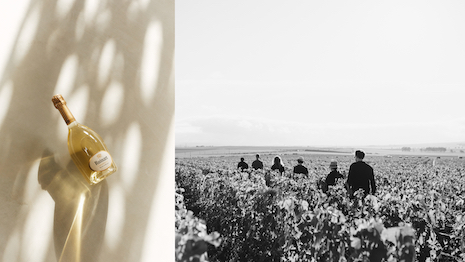 Ruinart's Champagne property will inform the projects. Image credit: Ruinart
Ruinart's Champagne property will inform the projects. Image credit: Ruinart
“There is a clear mutual benefit of positive cultural influence, and for me, it is about embedding the value of the natural environment into culture, and finding new ways we can relate across species' divides so that political, social and economic decisions are made 'in relation' to the planet,” said Mr. Coates, London.
“Hopefully luxury brands are recognizing the imperative of this approach also, but the question is, whether they recognize this as an intrinsic philosophy that is self-determining, or are these values used for show?” he said. “I think the public is understanding this nuance much more and is increasingly sophisticated in recognizing authenticity in a company's environmental intentions.
“Part of this shift for luxury brands must be to support the cultural activity that attempts to affect perspectives and positive change and not use 'art' with its often associated elitism as an accessory.”
Past Carte Blanche campaigns have been grounded in the creations of one person per year, from 2023’s French artist Eva Jospin (see story) to 2022’s Danish artist Jeppe Hein (see story).
No matter their materials of choice or place of origin, each pick allows the brand to inform their process, taking inspiration from grapes, vineyard rows or the soil itself. Even the packaging of Ruinart’s products has been a key muse for some.
Like this year’s group, sustainability has often been a major shaper of their work, whether that looks like using recycled paper or basing art around regenerative agriculture (see story).
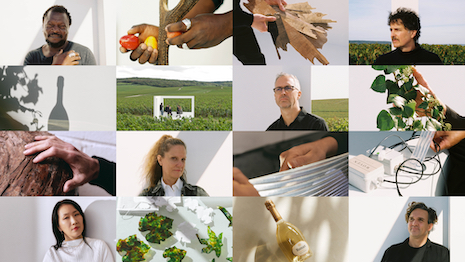 The six people specialize in different topics, but each is concerned with humankind's relationship with the planet. Image credit: Ruinart
The six people specialize in different topics, but each is concerned with humankind's relationship with the planet. Image credit: Ruinart
2024 marks the first time that the LVMH subsidiary has involved a collective, rather than a single figure for the effort.
Some of those tapped for Carte Blanche this time around are mainly focused on broad topics such as climate, while others dig deeply into issues of biodiversity. However, every one of them is invested in the human element of environmentalism.
Thanks to their eclectic backgrounds, the invitees will capture how the biggest global crises are perceived around the world — as a business that depends on earth-grown products, Ruinart often highlights these problems in programming and in-house operational shifts (see story).
Ms. Bowers complements this mission. Known for her combination of art and activism, her “artivism” studies environmental, women’s and immigration rights.
Based in Los Angeles, her work appears in major public collections globally.
Mr. Tayou likewise puts justice at the heart of his art, spanning installations, collages, sculptures, videos and photographs. Born in Cameroon and since immigrating to Sweden, France and, most recently, Belgium, his creations look at globalization using simple or recycled items.
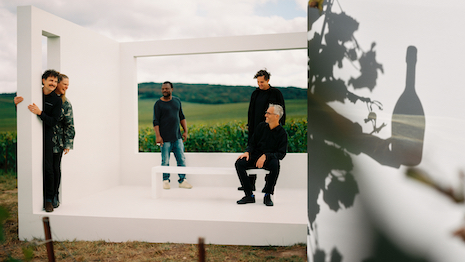 The group's work will go on tour this year. Image credit: Ruinart
The group's work will go on tour this year. Image credit: Ruinart
Granting older materials a second life as well, Mr. Oliveira from Brazil reuses planks sourced from pallets in a nod to the favelas in his country. Sustainable development is an issue he holds close.
Now based in London, the artist’s paintings are highly colorful. His sculptures, on the other hand, are generally earth-toned, appearing as giant vegetal roots emerging in urban spaces.
Mr. Coates also specializes in installations, turning to the use of paintings, photography, sculptures and sound work to express his points. Envisioning encounters with imagined animals, empathy is a serious sticking point for him.
“Ruinart is using their scientific research to confront the effectiveness of 'modern' vineyard practices and its reliance on chemical pest and weed control,” said Mr. Coates.
“They have introduced methods that increase biodiversity to improve soil health,” he said. “Interestingly for me, this includes the revitalization and protection of surrounding natural habitats like grasslands and woodlands that have benefits to a wider group of species.
“An emphasis on finding cultural as well as economic value in increased biodiversity is a key theme of my work.”
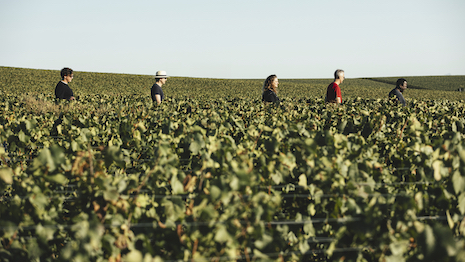 The artists will receive higher exposure in exchange for uplifting the brand's green ethos through their crafts. Image credit: Ruinart
The artists will receive higher exposure in exchange for uplifting the brand's green ethos through their crafts. Image credit: Ruinart
Born in Japan but living in Paris, Ms. Sauvage takes an experimental approach to music, specializing in capturing the transformative characteristics of natural elements.
Similar to French singer-songwriter Anabelle Boule, a recent collaborator of crystal maker Baccarat (see story), the artist makes music using porcelain bowls filled with water. She is also famous for her research on the sound effects of bubbles.
Mr. Biersteker is also deeply informed by data. Committed to ecology, he works with renowned scientists and institutions, bringing emotion to metrics-oriented facts.
“I can’t speak for other artists, but having a brand that is committed to acting on climate change based on the data they collect is something that heavily reflects my work, like in ‘Wither,’ ‘eContinuum,’ or at the Fondation Cartier's work ‘Symbiosia,’” he said.
“I feel honored.”
Whatever ends up being brought together by all, “Conversations with Nature” will gather five different prisms and contemporary art forms to get at one point: humans need a healthy planet, and so does Ruinart.
RuinART
Sustainability has long been of major importance to Ruinart (see story).
Often, this is expressed through artistic endeavors. Even outside the Carte Blanche tradition, creatives who care about nature are frequently tapped as partners (see story).
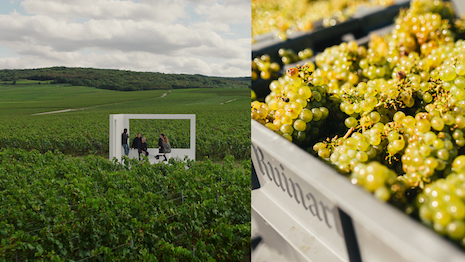 The brand has made art a key piece of its identity. Image credit: Ruinart
The brand has made art a key piece of its identity. Image credit: Ruinart
Over the last few years, the maison has also focused its activations at Frieze Art Fairs on topics like responsible viticulture and transparency.
In May 2023, the house showcased the importance of New York City’s urban green spaces and eco-friendly harvesting. With a shared commitment to enhancing biodiversity and protecting native plants, the label worked with The High Line, a park built above Manhattan’s West Side streets along an old freight line (see story).
A year before in Los Angeles, Ruinart turned to San Francisco-based artist and eco-activist Suzanne Husky for its third R.U.in.ART commission, an initiative founded for the inaugural Frieze in 2019 (see story).
“Artists are the best ambassadors to promote the preservation of nature, which is essential for Maison Ruinart,” said Frédéric Dufour, president of Ruinart, in a statement.
“They are at the cutting edge of society and have a powerful language capable of engaging our different audiences.”